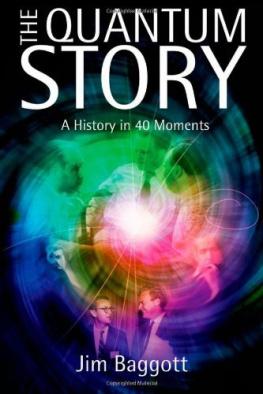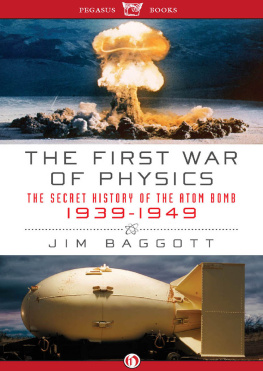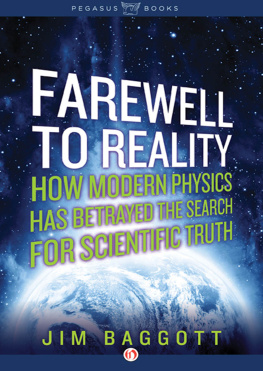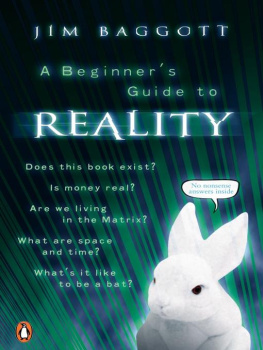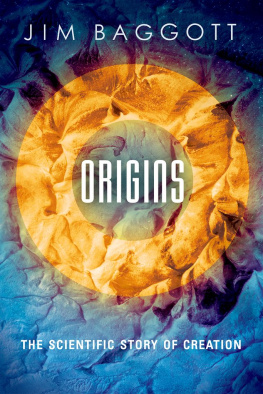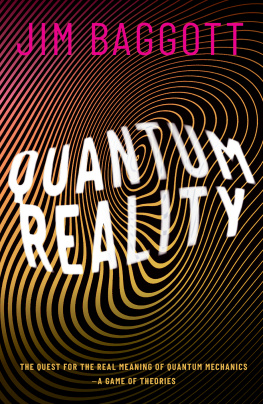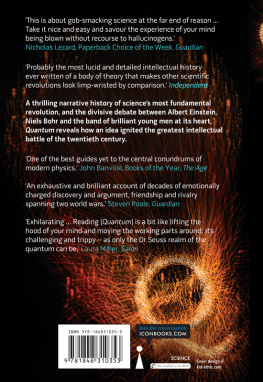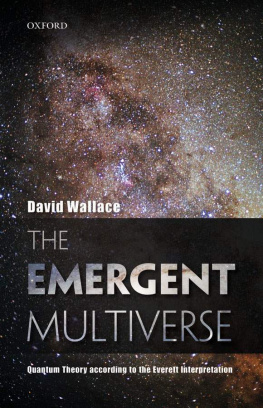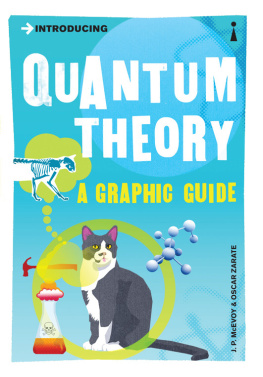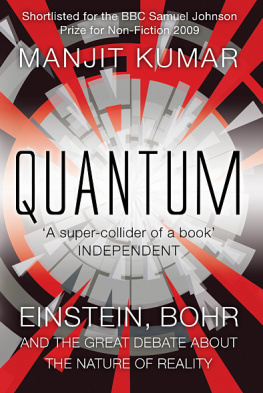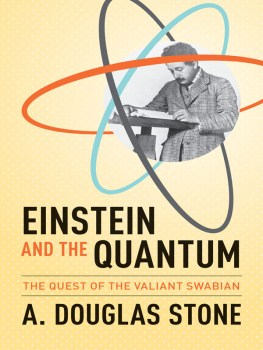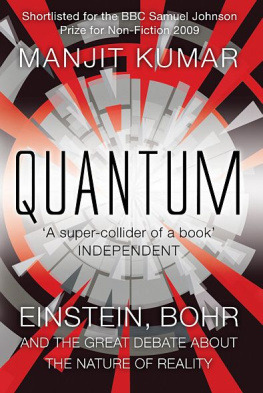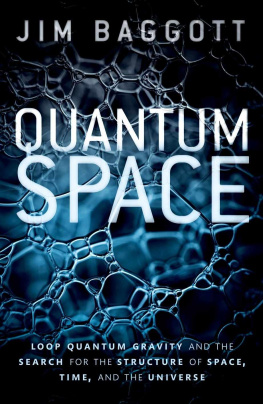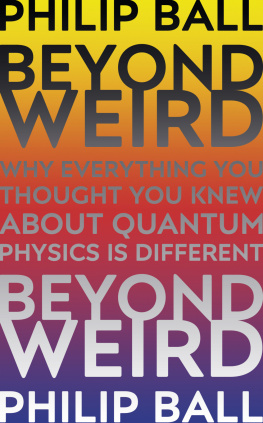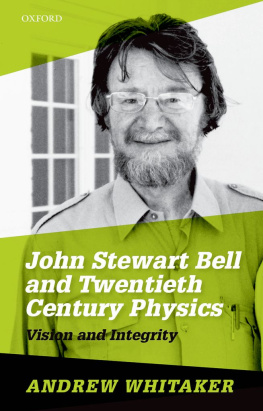THE QUANTUM STORY
THE
Quantum Story
A HISTORY IN 40 MOMENTS
JIM BAGGOTT


Great Clarendon Street, Oxford ox2 6DP
Oxford University Press is a department of the University of Oxford. It furthers the Universitys objective of excellence in research, scholarship, and education by publishing worldwide in Oxford New York
Auckland Cape Town Dar es Salaam Hong Kong Karachi Kuala Lumpur Madrid Melbourne Mexico City Nairobi New Delhi Shanghai Taipei Toronto With offices in
Argentina Austria Brazil Chile Czech Republic France Greece Guatemala Hungary Italy Japan Poland Portugal Singapore South Korea Switzerland Thailand Turkey Ukraine Vietnam
Oxford is a registered trade mark of Oxford University Press in the UK and in certain other countries
Published in the United States by Oxford University Press Inc., New York
Jim Baggott 2011
The moral rights of the authors have been asserted Database right Oxford University Press (maker)
First published 2011
All rights reserved. No part of this publication may be reproduced, stored in a retrieval system, or transmitted, in any form or by any means, without the prior permission in writing of Oxford University Press, or as expressly permitted by law, or under terms agreed with the appropriate reprographics rights organization. Enquiries concerning reproduction outside the scope of the above should be sent to the Rights Department, Oxford University Press, at the address above
You must not circulate this book in any other binding or cover and you must impose the same condition on any acquirer
British Library Cataloguing in Publication Data Data available
Library of Congress Cataloging in Publication Data Data available
Typeset by SPI Publisher Services, Pondicherry, India Printed in Great Britain on acid-free paper by Clays Ltd, St Ives plc
ISBN 9780199566846
10 9 8 7 6 5 4 3 2 1
For MSS,
because every student deserves
at least one great teacher
CONTENTS
Prologue: Stormclouds
London, April 1900
1 The Most Strenuous Work of My Life
Berlin, December 1900
2 Annus Mirabilis
Bern, March 1905
3 A Little Bit of Reality
Manchester, April 1913
4 la Comdie Franaise
Paris, September 1923
5 A Strangely Beautiful Interior
Helgoland, June 1925
6 The Self-rotating Electron
Leiden, November 1925
7 A Late Erotic Outburst
Swiss Alps, Christmas 1925
8 Ghost Field
Oxford, August 1926
9 All This Damned Quantum Jumping
Copenhagen, October 1926
10 The Uncertainty Principle
Copenhagen, February 1927
11 The Kopenhagener Geist
Copenhagen, June 1927
12 There is No Quantum World
Lake Como, September 1927
13 The Debate Commences
Brussels, October 1927
14 An Absolute Wonder
Cambridge, Christmas 1927
15 The Photon Box
Brussels, October 1930
16 A Bolt from the Blue
Princeton, May 1935
17 The Paradox of Schrdingers Cat
Oxford, August 1935
Interlude: The First War of Physics
Christmas 1938August 1945
18 Shelter Island
Long Island, June 1947
19 Pictorial Semi-vision Thing
New York, January 1949
20 A Beautiful Idea
Princeton, February 1954
21 Some Strangeness in the Proportion
Rochester, August 1960
22 Three Quarks for Muster Mark!
New York, March 1963
23 The God Particle
Cambridge, Massachusetts, Autumn 1967
24 Deep Inelastic Scattering
Stanford, August 1968
25 Of Charm and Weak Neutral Currents
Harvard, February 1970
26 The Magic of Colour
Princeton/Harvard, April 1973
27 The November Revolution
Long Island/Stanford, November 1974
28 Intermediate Vector Bosons
Geneva, January/June 1983
29 The Standard Model
Geneva, September 2003
30 Hidden Variables
Princeton, Spring 1951
31 Bertlmanns Socks
Boston, September 1964
32 The Aspect Experiments
Paris, September 1982
33 The Quantum Eraser
Baltimore, January 1999
34 Lab Cats
Stony Brook/Delft, July 2000
35 The Persistent Illusion
Vienna, December 2006
36 The Wavefunction of the Universe
Princeton, July 1966
37 Hawking Radiation
Oxford, February 1974
38 The First Superstring Revolution
Aspen, August 1984
39 Quanta of Space and Time
Santa Barbara, February 1986
40 Crisis? What Crisis?
Durham, Summer 1994
Epilogue: A Quantum of Solace?
Geneva, March 2010
ABOUT THE AUTHOR
Jim Baggott is an award-winning science writer. A former academic scientist, he now works as an independent business consultant but maintains a broad interest in science, philosophy, and history, and continues to write on these subjects in his spare time. His previous books have been widely acclaimed and include:
Atomic: The First War of Physics and the Secret History of the Atom Bomb 193949 (Icon Books, 2009);
A Beginners Guide to Reality (Penguin, 2005);
Beyond Measure: Modern Physics, Philosophy and the Meaning of Quantum Theory (Oxford University Press, 2004);
Perfect Symmetry: The Accidental Discovery of Buckminsterfullerene (Oxford University Press, 1994); and
The Meaning of Quantum Theory: A Guide for Students of Chemistry and Physics (Oxford University Press, 1992).
PREFACE
The last century was defined by physics. From the minds of the worlds leading physicists there flowed a river of ideas that would transport mankind to the very pinnacle of wonder and to the very depths of despair. This was a century that began with the certainties of absolute knowledge and ended with the knowledge of absolute uncertainty. It was a century in which physicists developed theories that would deny us the possibility that we can ever properly comprehend the nature of physical reality. It was also a century in which they built weapons with the capacity utterly to destroy this reality.
Almost everything we think we know about the nature of our world comes from one theory of physics. This theory was discovered and refined in the first thirty years of the twentieth century and went on to become quite simply the most successful theory of physics ever devised. Its concepts underpin much of the twenty-first century technology that we have learned to take for granted.
But this success has come at a price, for it has at the same time completely undermined our ability to make sense of the world at the level of its most fundamental constituents.
Rejecting the elements of uncertainty and chance implied by this new theory, Albert Einstein once famously declared that God does not play dice. Niels Bohr claimed that anybody who is not shocked by the theory has not understood it. The charismatic American physicist Richard Feynman went further: he claimed that nobody understands it. To anyone tutored in the language and the logic of classical physics, this theory is at once mathematically challenging, maddeningly bizarre, and breathtakingly beautiful.
This is quantum theory, and this book tells its story.
Next page
